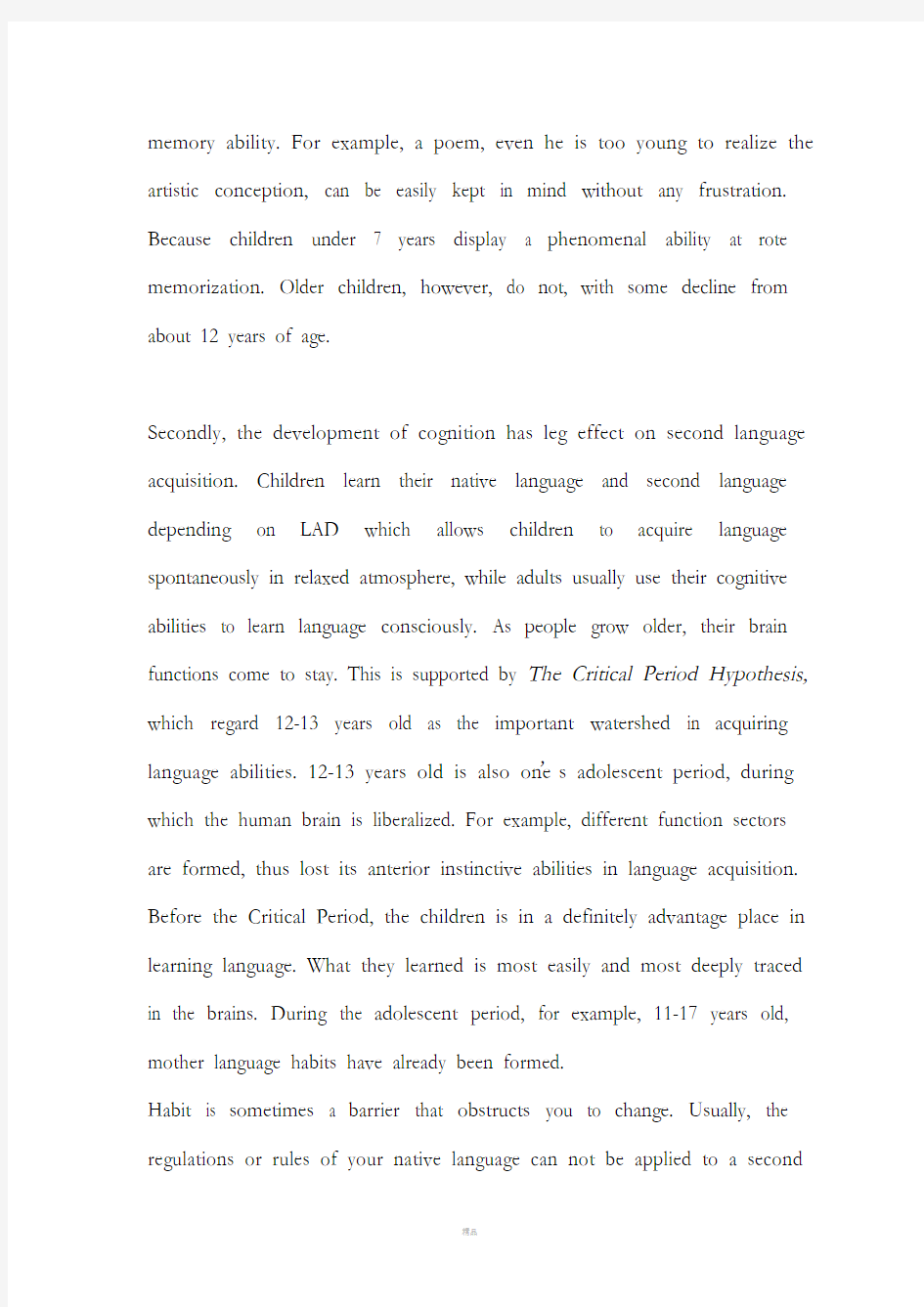

The Advantages Of Children Compared With Adults
On Second Language Acquisition
Nowadays, Along with frequent contact with other countries in the world, especially the English-speaking country, second language acquisition has been a hot topic that is popular in China. Many scholars think that individual differences are very important factors that may greatly affect the process of second language acquisition, including age, motivation, cognitive factors and so on. These differences vary, and have direct impact on learning achievement and ultimately the availability of a second language. Some parents push their children to learn second language, for example, English, as early as possible. Because they consider that the younger the easier to learn second language. This paper will analyze the advantages of children second-language acquisition compared with adults from the aspect of memory ability, cognition and emotion.
Firstly, the key period to learn language is between 2 to 12 years of age. There was a famous theme--The Critical Period Hypothesis, presented by Lenneberg in 1960s. He thought that the human brain in 2 to 12 years of age can acquire language easier due to the impact of Language Acquisition Device (LAD) in brains. Because both hemispheres of the brain join in learning language. That’s why young children have an extraordinary
memory ability. For example, a poem, even he is too young to realize the artistic conception, can be easily kept in mind without any frustration. Because children under 7 years display a phenomenal ability at rote memorization. Older children, however, do not, with some decline from about 12 years of age.
Secondly, the development of cognition has leg effect on second language acquisition. Children learn their native language and second language depending on LAD which allows children to acquire language spontaneously in relaxed atmosphere, while adults usually use their cognitive abilities to learn language consciously. As people grow older, their brain functions come to stay. This is supported by The Critical Period Hypothesis, which regard 12-13 years old as the important watershed in acquiring language abilities. 12-13 years old is also one’s adolescent period, during which the human brain is liberalized. For example, different function sectors are formed, thus lost its anterior instinctive abilities in language acquisition. Before the Critical Period, the children is in a definitely advantage place in learning language. What they learned is most easily and most deeply traced in the brains. During the adolescent period, for example, 11-17 years old, mother language habits have already been formed.
Habit is sometimes a barrier that obstructs you to change. Usually, the regulations or rules of your native language can not be applied to a second
language. So in order to learn a second language, the one should set up a new idea and a new consciousness. It is much easier for young children to do so, but for adults, it is hard to get rid of the old grammar rules. One typical example is Arnold Schwarzenegger, who is a foreign-born United States official and because governor of California in 2003. Born in Austria, he moved to the United States when he was 21. At present he speaks english with near-native speaker syntax, but with a strong German accent. That is also to say, children have not formed a native language habit entirely, so they face less obstructions from mother langue in learning second language.
Thirdly, emotional factors in second language acquisition play an important role and some western scholars believe that its role is even more important than cognitive factors. The emotional factors may hinder the learners to absorb input information because of a psychological barrier. Children has different learning motivation compared with adults. Learning motivation is a complicated phenomenon consisting of the desire of success, the efforts and satisfaction on goal realization. Generally, children are more likely to integrate to second language, while adults who satisfied with the gained level and capacity are not willing to integrate to second language.
In addition, children learn language without the impact of emotional factors and even can not recognize that they are learning language. By this way, children can learn language without pressure. However, with the
enhancement of self-awareness, adults have a fear of making language mistakes when they put their second language into use, which reduces not only the opportunities to contact with second language but also the interest of learning second language. That means children usually can keep active attitude in second language acquisition.
In conclusion, with good memory, less language cognition and active learning attitude, children have more advantages in learning second language. Therefore, it is an irresistable trend to start English-teaching in childhood in Chinese eduction.
References:
[1] Ellis, r. (1994). The Study Of Second Language Acquisition[M].Oxford University Press.
[2]Krashen, Stephen D. (1988). Second Language Acquisition and Second Language learning. Prentice-Hall Inter national.
[3] Skehan, p. (1991,13). Individual Differences In Second Language Acquisition[J]. SSLA.
[4] Bista.Krishna K. (2003). Age As An Affective Factors In Second Language Acquisition. NY:Troy University.
[5]彭坚,二语习得“关键期假说”的反思性研究【J】.学前教育研究,2007,(5):53-55.
[6] 蒋剑云,戴运财,2000(4),年龄与二语习得【J】.山东:山东师大外国语学
院学报.
[7]杨萍,王小宁.儿童英语学习的优势及原则[J].学前教育研究,2007,(4):28